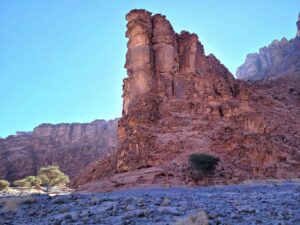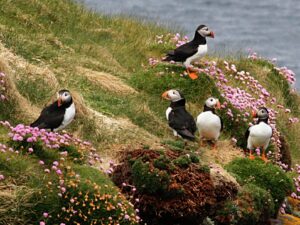On February 12, a couple of weeks before the world started shutting down, Alice Morrison completed a 2,000km walk across the Sahara. Originally from Scotland and now living in Marrakech, the 57-year-old Morrison has decided she wants to walk the length of Morocco. Her walk across the Sahara was the second leg of her three-part Moroccan odyssey.

Photo: Alice Morisson
Born in Edinburgh, Morrison grew up in Ghana and Uganda before returning to Scotland when she was 11 years old. After studying Arabic and Turkish at university, she spent two years teaching English in Cairo, then worked as a journalist for BBC World TV and then BBC Arabic TV, quickly rising through the ranks to be co-editor of BBC News. In 2002, she became started to take on “mini-adventures”. During her holidays, she squeezed in the Snowdon Challenge, crossed Costa Rica coast to coast, did Kilimanjaro, ice climbed in the Andes and climbed the Ruwenzoris.
In 2011, she “left the rat race for the bike race” and cycled Africa on the Tour d’Afrique –- 12,000km across four months. She then decided to sign up for the Marathon des Sables, a 251km desert race, and moved to Marrakech to train. She thought she would be there for five months, but loved it so much she never left and decided to become a full-time adventurer.
Since moving to Morocco, she has not completely left her media work behind. In 2017, she presented the BBC2 series, From Morocco to Timbuktu, and has written several books on her adventures.

The route across Morocco. Photo: Alice Morrison
In 2019, she set out to become the first woman to walk the length of Morocco. Her original idea was just to walk the 1,200km length of the Draa River. When she completed this, she became the first woman ever to do so. She picked this route because “a river is a very nice, easy geographical thing to understand”.
She planned the trip with the help of an old friend, Jean-Pierre Datcharry, who himself has previously traversed North Africa on foot with camels. He advised her when to go, the government clearance she needed and the militarized zones she had to cross. Her camels and guides came from his team. Afterwards, Datcharry asked why she wasn’t finishing a crossing of Morocco. She didn’t have an answer, so she began planning the rest of her expedition.
Morrison set off on November 26, from Oued Chbika, where she completed her Draa River walk, with the aim of making it to the Guergerat on the Mauritanian border. She walked with three local guides, Brahim Ahalfi, Lhou, Addi Bin Youssef and six camels. “I would have died without them,” she says.
Rather than have a safety car, she opted for the “old-school way”. Camels carried the water and food, and they asked locals where the water was. None of these wells are marked, but are found by word of mouth. Some lay 200km apart.
She crafted a trip that had an old-fashioned sense of exploration. That’s what she most loved about it. They had planned the route as a team, considering the military zones, totally dry areas and those places where there were no nomads to point out the wells. Here, they had to stick close to a paved road, so that they could stop the water trucks to replenish their supplies.
They planned the route “in very broad strokes”, according to Morrison, with fixed points 12 to 15 days apart. Brahim, an experienced desert guide, navigated by using the sun. An occasional glance at Google Earth confirmed that they were still on course. They covered an average of 25km a day, but since they couldn’t carry food for the entire trip, they had to make occasional detours up to 100km to the nearest town. Thus they zigzagged their way across the Sahara.

Skirting the sand dunes. Photo: Alice Morisson
Two-and-a-half months in the desert meant that the right kit was essential. It was warm during the day and freezing at night. With such limited water, washing was impossible. Finally, it was culturally inappropriate here for either a man or a woman to show any flesh, so no cool shorts or sleeveless shirts.
At night, she used boot covers to stop scorpions and ticks from hiding in her footwear as she slept. Since scorpions and snakes were a constant threat, they carried antivenom as part of their first-aid kit. But the animals ended up needing the kit more than any of them.
The winds, she said, “were relentless, absolutely excruciating and very, very strong”. It was their greatest challenge. When they stopped walking, they couldn’t even sit outside their tents. Luckily, it “was like God would switch [the wind] off at six o’clock each night”.
The tents, designed by her old friend Jean-Pierre, were based on a traditional nomadic style. Steel and iron poles propped up the heavy-duty canvas. Coping stones moored the tent against the Saharan winds.
The wind may have been the most challenging, but quicksand and landmines were far more dangerous. Near the end of the expedition, they had to cross a minefield for a week. They had no precautions beyond following local advice to stay on the piste. This was not always easy, because half her group consisted of grazing animals with a penchant to wander.

Camp in the Sahara. Photo: Alice Morrison
Morrison admits this expedition was much harder than her 1,200km walk along the Draa River, and significantly harder than she expected. “The best thing an adventurer can have is a very short memory and very high level of optimism,” she says.
They were walking faster, further and through much different terrain than the Draa River journey. “We just had endless flat and blue sky for weeks,” she said. “It was so monotonous.” A critical time mentally came one month in, when the water they were drinking was so salty that it couldn’t slake her thirst. She had to learn to take it in stride. “I thought, right, this is the new reality. You’re not going to die of thirst because this will hydrate you. You’re just going to have to accept it. But that was a very difficult time.”
A few surprises, or “treats from God”, broke up the monotony, such as seeing a desert fox for the first time. At well-used bivouac sites, clearly “the only sane place to camp” in an area, they found not only the occasional sardine tin or discarded shoe, but stone-age tools: knives, flints and arrowheads. Seeing the “unbroken line of history gave you such a feeling of being part of the human race as a whole,” she said. “It really filled my soul.”

Dog, camel and Alice in the Sahara. Photo: Alice Morrison
The third and final leg of her Moroccan Odyssey will traverse the Atlas Mountains, from Nador in the north to Ouarzazate, where she started her Draa River trek. The same team — who, she says, “are everything to me” — will accompany her. She had planned to start in June, but with Morocco under lockdown from COVID-19, she will likely have to begin later than expected.






